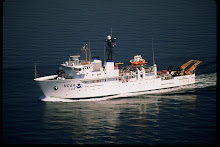
Today was our opportunity to take it a little easier as compared to yesterday’s long day of buoy recovery and deployment that did not end until after dark. We had an opportunity to catch-up on some email and work on an article that is due on the 15th of January. Nothing like being under a time crunch to get you motivated. The day is filled with sun and winds are "fresh" as it is called by some.
The first order of business was to help with the 3N: 155W shallow cast CTD. It is still had to grasp that shallow is over 3000 feet down into the ocean. When the pressure of the water increases the equivalent of 1 atmosphere each 10 meters that is a lot of pressure when something goes down 1000 meters like the shallow CTD does. When we make our deep cast (3000 meters) at the equator the pressure on the instruments is staggering. What would it be in pounds per square inch?

 If followers look back to a post from October they can see the stickers that the students at Billings Senior High Freshman Academy prepared for the drifter they were adopting through NOAA’s Adopt-A-Drifter Program. If you are interested in adopting a drifter you can find information about the program in the “links to learning a little more” area of this Blog.
If followers look back to a post from October they can see the stickers that the students at Billings Senior High Freshman Academy prepared for the drifter they were adopting through NOAA’s Adopt-A-Drifter Program. If you are interested in adopting a drifter you can find information about the program in the “links to learning a little more” area of this Blog.
 One gains a whole new perspective and respect for the power of the Ocean and the scientists who routinely build these buoys so that good data can be collected to help mankind.
One gains a whole new perspective and respect for the power of the Ocean and the scientists who routinely build these buoys so that good data can be collected to help mankind. One added benefit of working on the buoys is that occasionally we have the chance to do a little personalizing. Art painted MSU CATS on one side since he works at MSU and since I just graduated from Bozeman last May. On the other side Rick put in a plug for Billings Senior Broncs. So now the Broncs and the Cats will be part of the TAO array at 155W at the equator for the next year.
One added benefit of working on the buoys is that occasionally we have the chance to do a little personalizing. Art painted MSU CATS on one side since he works at MSU and since I just graduated from Bozeman last May. On the other side Rick put in a plug for Billings Senior Broncs. So now the Broncs and the Cats will be part of the TAO array at 155W at the equator for the next year.



No comments:
Post a Comment